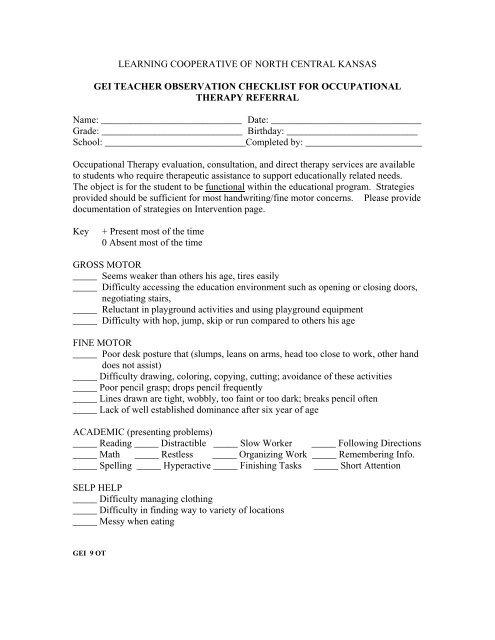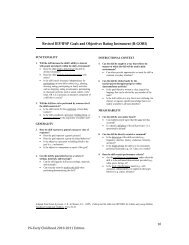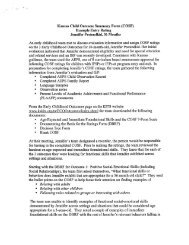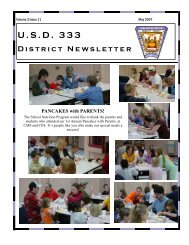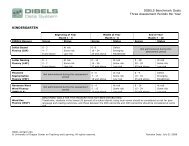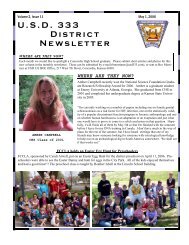gei teacher observation checklist for occupational therapy - Usd 333
gei teacher observation checklist for occupational therapy - Usd 333
gei teacher observation checklist for occupational therapy - Usd 333
You also want an ePaper? Increase the reach of your titles
YUMPU automatically turns print PDFs into web optimized ePapers that Google loves.
LEARNING COOPERATIVE OF NORTH CENTRAL KANSAS<br />
GEI TEACHER OBSERVATION CHECKLIST FOR OCCUPATIONAL<br />
THERAPY REFERRAL<br />
Name: _____________________________ Date: _______________________________<br />
Grade: _____________________________ Birthday: ___________________________<br />
School: _____________________________Completed by: ________________________<br />
Occupational Therapy evaluation, consultation, and direct <strong>therapy</strong> services are available<br />
to students who require therapeutic assistance to support educationally related needs.<br />
The object is <strong>for</strong> the student to be functional within the educational program. Strategies<br />
provided should be sufficient <strong>for</strong> most handwriting/fine motor concerns. Please provide<br />
documentation of strategies on Intervention page.<br />
Key<br />
+ Present most of the time<br />
0 Absent most of the time<br />
GROSS MOTOR<br />
_____ Seems weaker than others his age, tires easily<br />
_____ Difficulty accessing the education environment such as opening or closing doors,<br />
negotiating stairs,<br />
_____ Reluctant in playground activities and using playground equipment<br />
_____ Difficulty with hop, jump, skip or run compared to others his age<br />
FINE MOTOR<br />
_____ Poor desk posture that (slumps, leans on arms, head too close to work, other hand<br />
does not assist)<br />
_____ Difficulty drawing, coloring, copying, cutting; avoidance of these activities<br />
_____ Poor pencil grasp; drops pencil frequently<br />
_____ Lines drawn are tight, wobbly, too faint or too dark; breaks pencil often<br />
_____ Lack of well established dominance after six year of age<br />
ACADEMIC (presenting problems)<br />
_____ Reading _____ Distractible _____ Slow Worker _____ Following Directions<br />
_____ Math _____ Restless _____ Organizing Work _____ Remembering Info.<br />
_____ Spelling _____ Hyperactive _____ Finishing Tasks _____ Short Attention<br />
SELP HELP<br />
_____ Difficulty managing clothing<br />
_____ Difficulty in finding way to variety of locations<br />
_____ Messy when eating<br />
GEI 9 OT
TACTILE SENSATION<br />
_____ Withdraws from touch<br />
_____ Tends to wear only certain types of clothing<br />
_____ Tends to wear coat when not needed; will not allow shirt sleeves pulled up<br />
_____ Touches everything, learns through his fingers<br />
_____ Avoids being to close to others (doesn’t like being hugged, difficulty in lines<br />
_____ Seems to chew on clothing or objects<br />
VESTIBULAR SENSATION<br />
_____ Fearful of being off the ground and activities moving through space<br />
_____ Avoids playground equipment, such as slide, swing, jungle gyms<br />
_____ Excessive craving <strong>for</strong> swinging, bouncing, slides, merry-go-rounds, rocking<br />
AUDITORY PERCEPTION<br />
_____ Appears overly sensitive to sounds (environmental sounds, loud music, bells)<br />
_____ Does not appear to understand other people<br />
_____ Tends to talk to himself/herself, or makes noises<br />
_____ Has difficulty making himself/herself understood<br />
VISUAL PERCEPTION<br />
_____ Difficulty discriminating color, shapes, letters, numbers<br />
_____ Difficulty copying design, letters or numbers<br />
_____ Cannot complete art or construction projects<br />
_____ Easily visually distracted<br />
EMOTIONAL<br />
_____ Does not accept changes in routine easily<br />
_____ Is easily frustrated<br />
_____ Acts out behaviorally; difficulty getting along with others<br />
_____ Accident prone<br />
_____ Seems to be preoccupied or distracted by issues not related to task at hand<br />
_____Frequently involves self in others activities<br />
Additional In<strong>for</strong>mation ____________________________________________________<br />
________________________________________________________________________<br />
________________________________________________________________________<br />
GEI 9 OT
“Have you tried…”<br />
Classroom Instructional Strategies<br />
The child has an awkward pencil grasp and the written work is not legible.<br />
How can I help?<br />
Have the child play with clay frequently.<br />
Have activities where the child pinches clay between the thumb and index finger,<br />
keeping the fingers in a round “O” shape with all the finger joints bent.<br />
Have the child do frequent, simple, writing/drawing activities while lying on their<br />
stomach on the floor with their arms resting on the floor.<br />
Mark the child’s pencil with a dot on each side of the pencil barrel across from one<br />
another. Place them about one inch above where the paint begins at the sharpened<br />
end. The child places the thumb on one dot and the index finger on the other end<br />
pinches the pencil, <strong>for</strong>ming these fingers into an “O” shape. The middle finger rests<br />
under the pencil and the little and ring fingers are curled into the hand (they are in<br />
bed).<br />
Have the child use different pencils grips (stereo – glob shaped grip with indentations<br />
<strong>for</strong> finger placement)<br />
Have the child use a small pencil about 3 inches long or smaller.<br />
Have the child place a tissue or cotton ball in the palm of their hand. The middle, the<br />
ring and little finger are to hold (hide) the object – that is their (fingers) job. This allows<br />
the index finger and the thumb to hold the pencil appropriately.<br />
Have the child write on different media (chalkboard, sandpaper, construction paper,<br />
raised line paper).<br />
How can I help the left-handed writer from developing an awkward grasp?<br />
Those children who prefer left-handed writing should be encouraged to do so. They<br />
should be encouraged early in their writing to use good pencil grasp.<br />
Have the child hold the pencil just like a right-handed person would hold a pencil, but<br />
the pencil is in the left hand.<br />
The hand that holds the pencil should be below the writing line, not above it.<br />
Paper positioning is important.<br />
The <strong>teacher</strong> should demonstrate writing to the left-handed student using the left hand.<br />
Though this may be difficult <strong>for</strong> some of us.<br />
GEI 9 OT
What do I do <strong>for</strong> the child who keeps the fingers right on the pencil lead<br />
when writing?<br />
Encourage the child to learn what it feels like to hold the pencil up on the paint,<br />
instead of near the lead: put a rubber band around the pencil about one inch above<br />
where the paint begins and prompt the child to keep his/her fingers on, or just above<br />
the rubber band.<br />
Encourage a reward program, but make it sporadic so the child does not become<br />
dependent upon the reward.<br />
Dots, or other marks, on the pencil barrel to cue the child as top proper finger<br />
placement will also help.<br />
Why is it important to have children write large at first?<br />
This encourages hand muscle control <strong>for</strong> fine motor and visual perceptual skills.<br />
The child is more able to experiment and establish appropriate patterns <strong>for</strong> when it<br />
comes to written communication.<br />
What can I do <strong>for</strong> the child who writes very darkly, like charcoal?<br />
Have the child play “ghost writing.” The child writes a word lightly on the paper and<br />
then has to erase it without leaving marks. The child wins if they can do this. Talk<br />
about “lifting the pencil tip off the paper” as the child writes.<br />
Set up a reward program. If the child writes too darkly, give points <strong>for</strong> every letter that<br />
is written lightly with more appropriate pressure on the paper. Initially, <strong>for</strong> five points<br />
you give a sticker. As the child improves, you increase the number of points needed<br />
to get a sticker to 10, 15, 20, etc. You can also increase the volume of writing needed<br />
to get a sticker or reward.<br />
What can I do <strong>for</strong> the child who writes too lightly and doesn’t press on the<br />
paper?<br />
Have the child use a larger pencil, this will build confidence that the pencil will not slip<br />
out of their hands.<br />
Try wrapping a rubber band about one inch up from where the paint begins and the<br />
child can place his/her fingers on the rubber band to prevent slippage.<br />
Pencil grips may be used, but not depended upon if you can help it.<br />
Have the child rub a crayon hard on a piece of paper to make layers of wax or<br />
completely cover a picture so that it can’t be seen.<br />
A reward program may also be set up.<br />
How do I help the child who doesn’t leave spaces between words?<br />
Have the child say the letter right be<strong>for</strong>e he/she writes them. Then when they get to a<br />
space have them say “space.”<br />
Have the child use their finger or penny <strong>for</strong> a spacer.<br />
GEI 9 OT
How can I help the child who frequently reverses letters (writes them<br />
backwards), especially “d” and “b” or can’t remember how to <strong>for</strong>m letters?<br />
Have the child learn (or relearn) how to properly start the specific letters and what the<br />
first movement is from the start point.<br />
The letter “b” should always be started on the top of the line and then go down,<br />
<strong>for</strong>ming a “baseball bat” ad then the “ball.”<br />
The “d” should always begin on the middle line of first and second grade writing paper.<br />
The child should start by writing a “c” shape, making a “dog dish,” and then go up <strong>for</strong><br />
the “dog’s leash.”<br />
To rein<strong>for</strong>ce the “d” shape by starting all similar printed letters with the ball shape (a, c,<br />
d, g, o, q), with the “c” shape starting from the middle of the line on the writing paper<br />
and in the one o’clock position, as if the circle shape they make is on a clock face<br />
moving in a counterclockwise direction.<br />
What can I do <strong>for</strong> the child who has difficulty with scissoring tasks?<br />
Children who are first learning to use scissors should cut card weight junk mail,<br />
because it is an activity that is easily successful.<br />
Have the child snip the end of a piece of construction paper, making “fringe.”<br />
Have the child cut leftover scraps of construction paper into random pieces, and then<br />
use a glue stick to glue the pieces to another paper.<br />
GEI 9 OT


